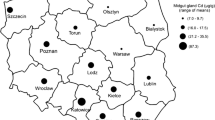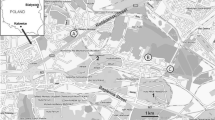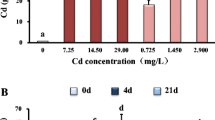Abstract
In terrestrial pulmonate snails, cadmium (Cd) uptake leads to the induction of a Cd-specific metallothionein isoform (Cd-MT) that protects against adverse interactions of this toxic metal ion. Increasing concentrations of Cd cause increased individual mortality possibly linked to pathological alterations in the snail midgut gland. Histological, immuno-histochemical, and electron-microscopic methods in combination with tissue metal analyses and quantification of MT induction parameters were applied to the midgut gland of Cd-exposed Roman snails (Helix pomatia). Conspicuous concentration-dependent alterations occurred in this organ, including the metal-induced increase of Cd-MT concentration and manifestation of Cd-MT mRNA precipitations in all midgut gland cell types. The most evident alteration was an increase of cellular turnover reflected by enhanced cell proliferation. Intensified vesiculation of endoplasmic reticulum was noted in basophilic cells and an increasing formation of lipofuscin granules in excretory cells. At the highest Cd concentrations, mitochondrial membranes were disrupted in basophilic cells, and lipofuscin granules were released from excretory cells into the midgut gland tubular system. Some of these alterations (e.g., increased cell proliferation rate, vesiculation of endoplasmic reticulum) detected at low Cd concentrations were interpreted as adaptive response processes enhancing the tolerance of exposed individuals to metal stress. Cellular alterations at higher Cd concentrations (e.g., mitochondrial structural damage) clearly represented ongoing irreversible cellular disruption. Combined evaluation of cellular biomarkers and MT saturation levels indicated that the transition from stress resistance to depletion of resistance capacity occurred above a threshold of 0.8 µmol Cd/g dry weight in the midgut gland of H. pomatia. At these Cd concentrations, Cd-MT was saturated with Cd2+ ions, whereas at the cellular level, structural alterations turned into pathological deterioration.





Similar content being viewed by others
References
Berntssen MH, Aspholm OO, Hylland K, Wendelaar Bonga SE, Lundebye AK (2001) Tissue metallothionein, apoptosis and cell proliferation responses in Atlantic salmon (Salmo salar L.) parr fed elevated dietary cadmium. Comp Biochem Physiol C Toxicol Pharmacol 128:299–310
Brunk UT (1989) On the origin of lipofuscin; the iron content of residual bodies, and the relation of these organelles to the lysosomal vacuome. A study on cultured human glial cells. Adv Exp Med Biol 266:313–320
Butler RA, Roesijadi G (2001) Disruption of metallothionein expression with antisense oligonucleotides abolishes protection against cadmium cytotoxicity in molluscan hemocytes. Toxicol Sci 59:101–107
Cajaraville MP, Diez G, Marigomez IA, Angulo E (1990) Responses of basophilic cells of the digestive gland of mussels to petroleum hydrocarbon exposure. Dis Aquat Org 9:221–228
Calabrese EJ (2004) Hormesis: a revolution in toxicology, risk assessment and medicine. EMBO Rep 5:S37–S40
Calabrese EJ, Baldwin LA (2001) Hormesis U-shaped dose responses and their centrality in toxicology. Trends Pharmacol Sci 22:285–291
Chabicovsky M, Niederstaetter H, Thaler R, Hödl E, Parson W, Rossmanith W, Dallinger R (2003) Localisation and quantification of Cd- and Cu-specific metallothionein isoform mRNA in cells and organs of the terrestrial gastropod Helix pomatia. Toxicol Appl Pharmacol 190:25–36
Chabicovsky M, Klepal W, Dallinger R (2004) Mechanisms of cadmium toxicity in terrestrial pulmonates: programmed cell death and metallothionein overload. Environ Toxicol Chem 23:648–655
Chang M-H, Lin H-C, Hwang P-P (1998) Ca2+ uptake and Cd2+ accumulation in larval tilapia (Oreochromis mossambicus) acclimated to waterborne Cd2+. Am J Physiol Regul Integr Comp Physiol 274:1570–1577
Chang T-C, Chou W-Y, GGn C (2000) Protein oxidation and turnover. J Biomed Sci 7:357–363
Dallinger R (1993) Strategies of metal detoxification in terrestrial invertebrates. In: Dallinger R, Rainbow PS (eds) Ecotoxicology of metals in invertebrates. Lewis, Boca Raton, pp 245–289
Dallinger R (1996) Metallothionein research in terrestrial invertebrates: synopsis and perspectives. Comp Biochem Physiol 113C:125–133
Dallinger R, Berger B, Hunziker PE, Kägi JHR (1997) Metallothionein in snail Cd and Cu metabolism. Nature 388:237–238
Dallinger R, Berger B, Hunziker PE, Kägi JHR (1999) Structure and function of metallothionein isoforms in terrestrial snails. In: Klaassen C (ed) Fourth Interntational Metallothionein Meeting, Kansas City. Birkhäuser, Basel, pp 173–178
Dallinger R, Berger B, Triebskorn R, Köhler H (2001a) Soil biology and ecotoxicology. In: Barker GM (ed) The biology of terrestrial molluscs. CABI, Wallingford, pp 489–525
Dallinger R, Wang Y, Berger B, Mackay E, Kägi JHR (2001b) Spectroscopic characterization of metallothionein from the terrestrial snail, Helix pomatia. Eur J Biochem 268:4126–4133
Dallinger R, Chabicovsky M, Berger B (2004) Isoform-specific quantification of metallothionein in the terrestrial gastropod Helix pomatia L. I. Molecular, biochemical and methodical background. Environ Toxicol Chem 23:890–901
Dallinger R, Chabicovsky M, Hödl E, Prem C, Hunziker P, Manzl C (2005) Copper in Helix pomatia (Gastropoda) is regulated by one single cell type: differently responsive metal pools in rhogocytes. Am J Physiol 189:R1185–R1195
Dameron CT, Harrison MD (1998) Mechanisms for protection against copper toxicity. Am J Clin Nutr 67 (5 Suppl):1091S–1097S
Davis SR, Cousins RJ (2000) Metallothionein expression in animals: a physiological perspective on function. J Nutr 130:1085–1088
Dietrich HF, Fontane AR (1975) A decalcification method for ultrastructure of echinoderm tissues. Stain Technol 50:352–353
Dondero F, Piacentini L, Banni M, Rebelo M, Burlando B, Viarengo A (2005) Quantitative PCR analysis of two molluscan metallothionein genes unveils differential expression and regulation. Gene 345:259–270
Egg M, Höckner M, Brandstätter A, Schuler D, Dallinger R (2009) Structural and bioinformatic analysis of the Roman snail Cd-metallothionein gene uncovers molecular adaptation towards plasticity in coping with multifarious environmental stress.Mol Ecol 18:2426–2443
Fowler BA, Whittaker MH, Lipsky M, Wang G, Chen XQ (2004) Oxidative stress induced by lead, cadmium and arsenic mixtures: 30-day, 90-day, and 180-day drinking water studies in rats: an overview. Biometals 17:567–568
Gubrelay JU, Mehta A, Singh M, Flora SJ (2004) Comparative hepatic and renal toxicity of cadmium in male and female rats. J Environ Biol 25:65–73
Gupta SA (1977) Calcium storage and distribution in the digestive gland of Bensonis monticola (Gastropoda, Pulmonata): a histophysiological study. Biol Bull 153:369–376
Handy RD (2003) Chronic effects of copper exposure versus endocrine toxicity: two sides of the same toxicological process? Comp Biochem Physiol A 135:25–38
Henson MC, Chedrese PJ (2004) Endocrine disruption by cadmium, a common environmental toxicant with paradoxical effects on reproduction. Exp Biol Med (Maywood) 229:383–392
Herkovits J, Pérez-Coll C (2007) Acclimation to low level exposure of copper in Bufo arenarum embryos: linkage of effects to tissue residues. Int J Environ Res Public Health 4:166–172
Höckner M, Stefanon K, Schuler D, Fantur R, De Vaufleury A, Dallinger R (2009) Coping with cadmium exposure in various ways: the two helicid snails Helix pomatia and Cantareus aspersus share the metal transcription factor-2, but differ in promoter organization and transcription of their Cd-metallothionein genes. J Exp Zool A 311:776–787
Kägi JHR (1991) Overview of metallothionein. Methods Enzymol 205:613–626
Kammenga JE, Dallinger R, Donker MH, Köhler H-R, Simonsen V, Triebskorn R, Weeks JM (2000) Biomarkers in terrestrial invertebrates: potential and limitations for ecotoxicological soil risk assessment. Rev Environ Contam Toxicol 164:93–147
Klaassen CD, Liu J, Choudhuri S (1999) Metallothionein: an intracellular protein to protect against cadmium toxicity. Annu Rev Pharmacol Toxicol 39:267–294
Knigge T, Mann N, Parveen Z, Perry C, Gernhofer M, Triebskorn R, Köhler HR, Cannock M (2002) Mannosomes: a molluscan intracellular tubular membrane system related to heavy metal stress? Comp Biochem Physiol C Toxicol Pharmacol 131:259–269
Köhler H-R, Rahman B, Gräff S, Berkus M, Triebskorn R (1996) Expression of the stress-70 protein family (hsp70) due to heavy metal contamination in the slug, Deroceras reticulatum: an approach to monitor sublethal stress conditions. Chemosphere 33:1327–1340
Liu H, Bowes RC, van de Water B, Sillence C, Nagelkerke JF, Stevens JL (1997) Endoplasmic reticulum chaperones GRP78 and calreticulin prevent oxidative stress, Ca disturbances, and cell death in renal epithelial cells. J Biol Chem 272:21751–21759
Lowe DM, Clarke KR (1989) Contaminant-induced changes in the structure of the digestive epithelium of Mytilus edulis. Aquat Toxicol 15:345–358
Manzl C, Krumschnabel G, Schwarzbaum PJ, Dallinger R (2004) Acute toxicity of cadmium and copper in hepatopancreas cells from the Roman snail (Helix pomatia). Comp Biochem Physiol C 138:45–52
Marigomez I, Orbea A, Olabarrieta I, Etxeberria M, Cajaraville MP (1996) Structural changes in the digestive lysosomal system of sentinel mussels as biomarkers of environmental stress in mussel-watch programmes. Comp Biochem Physiol 113C:291–297
Miles AT, Hawksworth GM, Beattie JH, Rodilla V (2000) Induction, regulation, degradation, and biological significance of mammalian metallothioneins. Crit Rev Biochem Mol Biol 35:35–70
Oberley TD, Swanlund JM, Zhang HJ, Kregel KC (2008) Aging results in increased autophagy of mitochondria and protein nitration in rat hepatocytes following heat stress. J Histochem Cytochem 56:615–627
Odendaal JP, Reinecke AJ (2003) Quantifying histopathatological alterations in the hepatopancreas of the woodlouse Porcellio laevis (Isopoda) as a biomarker of cadmium exposure. Ecotoxicol Environ Saf 56:319–325
Romeis B (1989) Mikroskopische Technik, 17th edn. Urban and Schwarzenberg, Munich
Selye H (1976) Stress in health and disease. Butterworth, Boston
Spurr AR (1969) A low-viscosity epoxy resin embedding medium for electron microscopy. J Ultrastruct Res 26:31–42
Stohs SJ, Bagchi D, Hassoun E, Bagchi M (2001) Oxidative mechanisms in the toxicity of chromium and cadmium ions. J Environ Pathol Toxicol Oncol 20:77–88
Sumner AT (1965) The cytology and histochemistry of the digestive gland cells of Helix. J Microsc Sci 106:173–192
Terman A, Brunk UT (2006) Oxidative stress, accumulation of biological “garbage”, and aging. Antioxid Redox Signal 8:197–204
Thevenod F, Friedmann JM, Katsen AD, Hauser JA (2000) Up-regulation of multidrug resistance P-glycoprotein via nuclear factor−kappaB activation protects kidney proximal tubule cells from cadmium- and reactive oxygen species-induced apoptosis. J Biol Chem 275:1887–1896
Triebskorn R (1989) Ultrastructural changes in the digestive tract of Deroceras reticulatum (Müller) induced by a carbamate molluscicide and by metaldehyde. Malacologia 31:141–156
Triebskorn R, Köhler HR (1996) The impact of heavy metals on the grey garden slug, Deroceras reticulatum (Müller): metal storage, cellular effects and semi-quantitative evaluation of metal toxicity. Environ Pollut 93:327–343
Triebskorn R, Künast C (1990) Ultrastructural changes in the digestive system of Deroceras reticulatum (Mollusca; Gastropoda) induced by lethal and sublethal concentrations of the carbamate molluscicide Cloethocarb. Malacologia 32:89–106
Watjen W, Beyersmann D (2004) Cadmium-induced apoptosis in C6 glioma cells: influence of oxidative stress. Biometals 17:65–78
Wieser W (1981) Responses of Helix pomatia to anoxia: changes of solute activity and other properties of the haemolymph. J Comp Physiol [B] 141:503–509
Wimmer U, Wang Y, Georgiev O, Schaffner W (2005) Two major branches of anti-cadmium defense in the mouse: MTF-1/metallothioneins and glutathione. Nucleic Acids Res 33:5715–5727
Wu S-M, Hwang P-P (2003) Copper or cadmium pretreatment increases the protection against cadmium toxicity in tilapia larvae (Oreochromis mossambicus). Zool Stud 42:179–185
Zaldibar B, Cancio I, Marigomez I (2004) Circatidal variation in epithelial cell proliferation in the mussel digestive gland and stomach. Cell Tissue Res 18:395–402
Zaldibar B, Cancio I, Marigomez I (2007a) Reversible alterations in epithelial cell turnover in digestive gland of winkles (Littorina littorea) exposed to cadmium and their implications for biomarker measurements. Aquat Toxicol 81:183–196
Zaldibar B, Cancio I, Soto M, Marigomez I (2007b) Digestive cell turnover in digestive gland epithelium of slugs experimentally exposed to a mixture of cadmium and kerosene. Chemosphere 70:144–154
Zaldibar B, Cancio I, Soto M, Marigomez I (2008) Changes in cell-type composition in digestive gland of slugs and its influence in biomarkers following transplantation between a relatively unpolluted and a chronically metal-polluted site. Environ Pollut 156:367–379
Author information
Authors and Affiliations
Corresponding author
Additional information
This work was supported by a grant of the Austrian Science Foundation (FWF), project no. P19782 B03.
Rights and permissions
About this article
Cite this article
Hödl, E., Felder, E., Chabicovsky, M. et al. Cadmium stress stimulates tissue turnover in Helix pomatia: increasing cell proliferation from metal tolerance to exhaustion in molluscan midgut gland. Cell Tissue Res 341, 159–171 (2010). https://doi.org/10.1007/s00441-010-0980-x
Received:
Accepted:
Published:
Issue Date:
DOI: https://doi.org/10.1007/s00441-010-0980-x




